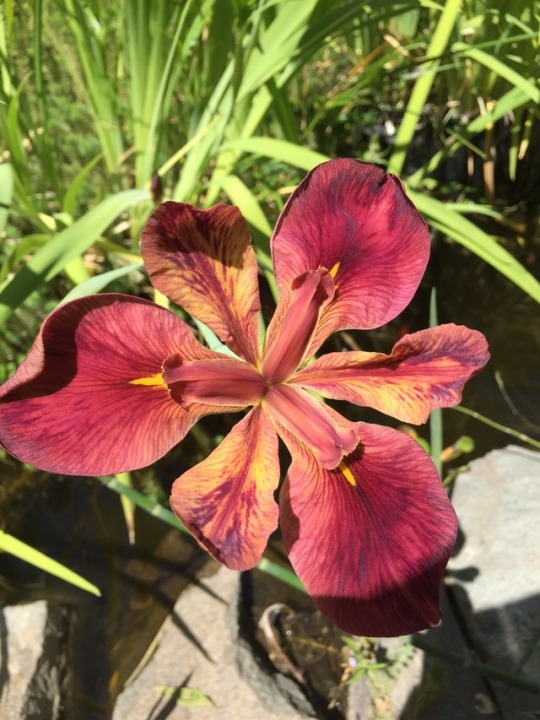#iris fulva
Text
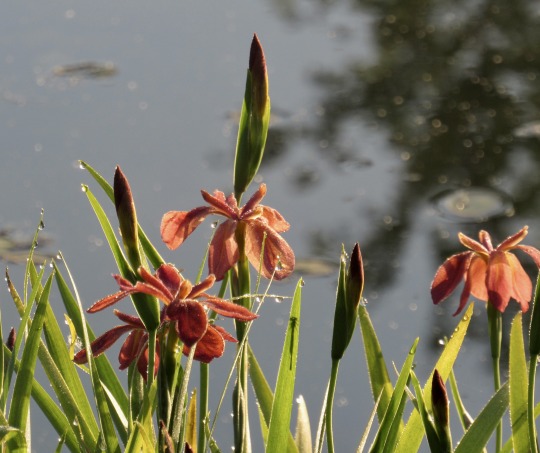
Iris fulva, copper iris, dripping with dew this morning at the lake. I didn't notice the dragonfly shadow on the leaf until I got home and downloaded the pictures.
#they planted it there as a “native” but it's native in the south not here#still pretty though#copper iris#iris fulva#pennsylvania#flowers#may#lake#springtime#taken with the camera
206 notes
·
View notes
Text
Root of the Month for February 2023 Jezebel Root

Jezebel Root: most notorious for it's use among sex workers and those of similar mind in domination, attraction, & crossing work.
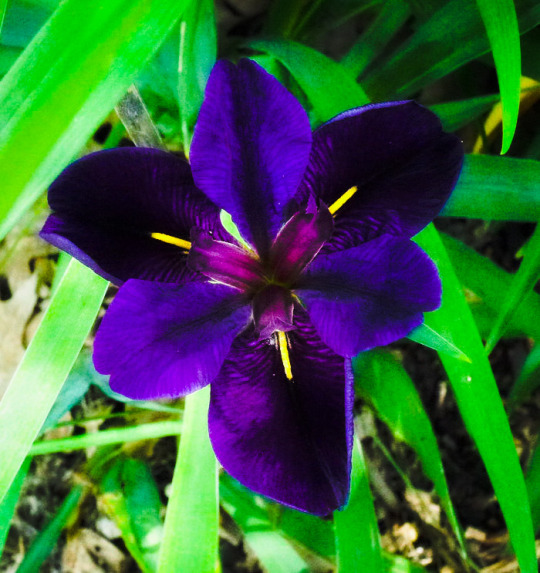
Taxa(Family/Genus/species): Iridaceae/Iris/foliosa or fulva or hexagona
Folk Nomenclature: "Queen Root"
Common Name: Louisiana Iris
Native Locality: North America
Phenotypic Traits: Numerous long, thick, stringy filaments
Parts Used: Root
Gender: Unknown, likely Hot
Planetary Ruler: Unknown; likely Venus or Mars
Elemental Ruler: Unknown; likely Earth or Fire
Traditional Usage in Rootwork: used in money, luck, & domination work predominately by sex workers to draw business success by attracting & controlling wealthy men or paying customers, invokes generosity, compels favor
Traditional Medicinal Usage: powerful liver stimulant; clears bile ducts, stimulates flow of siva, supports intestinal secretions, alleviate dropsy, & heals the lymphatic system.

🌟 FINAL copies of The2023 Hoodoo's Calendar are available for purchase (once sold out, that's it)! Subscribe to the official e-newsletter for the latest updates & exclusive content access. https://thehoodoocalendar.square.site 🌟
54 notes
·
View notes
Text
The Eternal Flower Files - Flowers of the Fleur de Lys

Sources: (2) Eternal Flower model from the Models Resource (3) Fleur de lys symbol by Frater5 on Wikimedia Commons
Eternal Flower Floette is likely inspired by the fleur de lys, an ancient trinity symbol used by French heraldry and Christianity. The story goes that the first King of France, King Clovis, adopted the fleur de lys as the symbol of France after he was given a lily by the Virgin Mary during his baptism. King AZ inherited Eternal Flower Floette from his late mother.
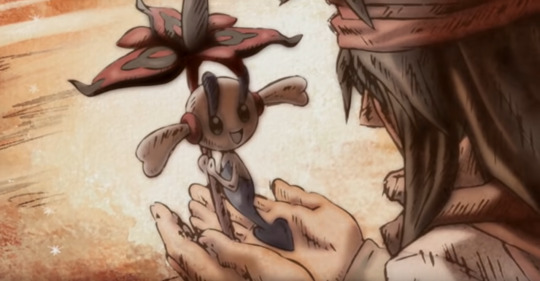
The fleur de lys is where Lysandre, the descendant of King AZ's brother, gets his name. In fact, lots of prominent Pokemon characters get their names from flowers associated with the fleur de lys, as we'll see.
"fleur de lys" means "flower of the lily", and yet the flower it actually depicts is surprisingly more subjective. Let's look at four flowers connected to the fleur de lys: the iris, the lily, the gladiolus, and the red trillium.
The Iris


Sources: (1) Caddo Parish Iris Fulva by MusselParty on Wikimedia Commons (cropped) (2) Giant Apostle Iris at Gardino Nursey Corp
The iris is the national flower of France. Despite being called the fleur de lys, the symbol is widely agreed to be an iris for a few reasons. Visually, the shape of the fleur de lys is the biggest evidence. Like the iris, the fleur de lys has three upright petals, or "standards" and three hanging petals called "falls".
Irises have a wide range of meanings depending on the color, but there are no natural red irises like the Eternal Flower. Irises like the Apostle Iris, Copper Iris, or Japanese Iris all resemble the Eternal Flower. In Ancient Greece, irises were planted at graves (and are still used as funeral flowers) to signal Iris, the goddess of light and rainbows to guide them into the afterlife. This symbol of "light" comes up a lot in Fleur de lys symbolism.
Did you know that not only does Champion Iris get her name from the flower, but also her counterpart Drayden, and his Blueberry Academy son Drayton?
The Lily
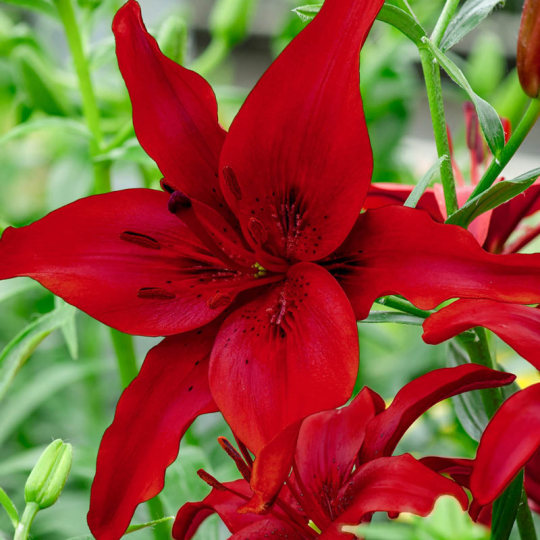

Sources: (1) Asiatic Highland Lily at Breck's, (2) Asiatic Blackout Lily at Degroot
The Eternal Flower looks a lot like the Asiatic Red Lily, or more specifically the Asiatic "Blackout Lily".
Lilies are one of the oldest cultivated flowers, so their name and symbolism has spread to many similar flowers over time. Lilies are incredibly important to Christianity. It is said that liles sprung from the tears of Eve as she left the Garden of Eden. Lilies are used to represent a lot of elements in Christianity, but mostly the Holy Trinity and the Virgin Mary. In a sense they are a trinity symbol themselves, symbolizing light and rebirth, tying into that familiar theme of "life, death, and rebirth".
Both lilies and irises flowers represent light in different ways. While Iris is the Greek goddess of light, the lily represents light in Christianity, and an archaic name for the Fleur de lys and the lily is "fleur de luce" or Flower of Light. These light symbols are likely where Eternal Flower Floette gets her "Light of Ruin" attack from. The attack has an connotation of authority and power, which is not surprising given the connection between "light" and many authoritative, ocassionally wrathful gods associated with light like the Abrahamic god, Zeus, and the Egyptian Goddess Isis.

This light symbolism might point to Eternal Flower Floette being the "lambda Pokemon" in the logo for Legends: Z-A. The symbol has a leafy pattern at the bottom reminiscent of flowers.
(L)ambda is used as a constant for (L)ight wavelengths. Floette in general use light and wavelengths to share power with flowers, but clearly the Eternal Flower has exceptional power of its own Maybe the "ominous power", the light within the Eternal Flower allowing Floette to use "Light of Ruin" - is Infinity Energy.
The Gladiolus
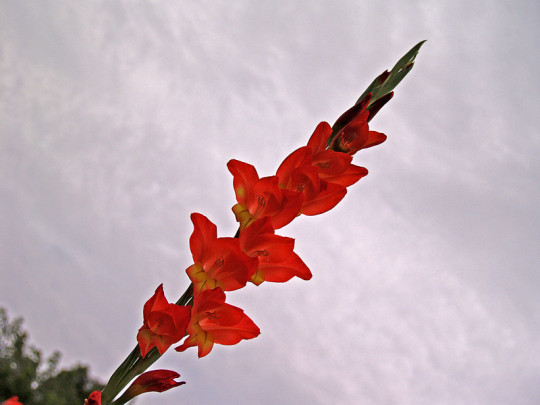
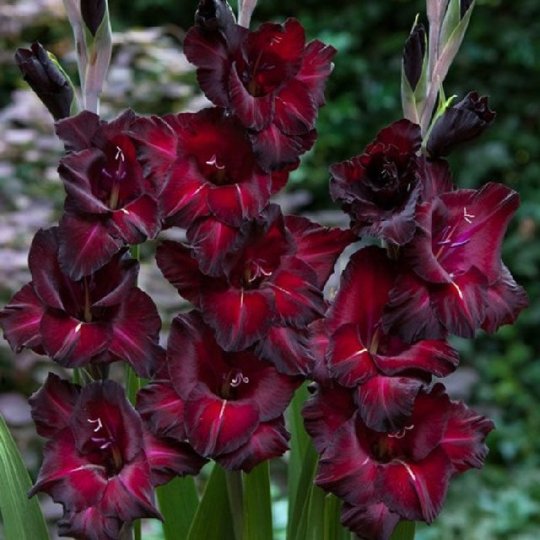
Sources: (1) AdaMacey, (2) Black Star Gladiolus Flower bulbs at WalMart.
The Gladiolus is in the iris family, but it has the nickname "Sword Lily" for its long pointy stalks. I think the Sword Lily inspires the black spikes on the ends of the larger petals on the Eternal Flower. The Sword Lily is said to symbolize the Virgin Mary in Our Lady of Sorrows, represented with swords piercing her body. This reminds me of the black spikes on the Eternal Flower, which look like they're piercing the bloodred petals..
And yes, the Aether kids Gladius and Lillie get their names from the Gladiolus and Lily! Notice that the Arceus crest on Type: Null's helmet makes it look like it has swords locking the helmet to its head. Of course, that's a larger discussion about Arceus and light/god imagery, but there are so many important Pokemon characters named after lilies and irises that it's hard to ignore that GameFreak was paying special attention to them.
The Trillium
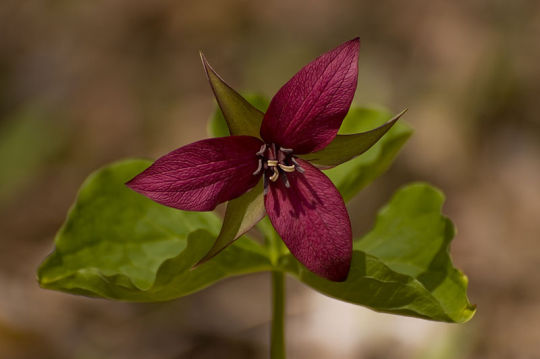

Sources: (1) Red Trillium 2010 by Saffron Blaze on Wikimedia, (2) Twisted Trillium by Hugh and Carol Nourse
The Red Trillium most likely inspired the Eternal Flower - so you may be wondering why I saved it for last. Unlike the ancient European history of the lily and iris, the Trillium was found in North America by European settlers. I say "found" and not "discovered" because Native Americans already used it medicinally. Since then, this relative of the lily has inherited a lot of European lily symbolism.
The symbolism of the Trillium seems to be a mixture of these two traditions. Native Americans used Trillium, also known as birthroot, as a female medicine for menstrual disorders, childbirth, and menopause. Midwifes would wear a trillium as a symbol of their work. (Source: Get to Know Trilliums - The Midwife's Medicine) It also has an antiseptic property, and was used to stop bleeding. This is where the trillium gets its symbolism of the divine female, blood, birth, and recovery.
Floette is a female only species, and notably Eternal Flower Floette seems to be connected to a lot of symbols of femininity, like the Virgin Mary, the Greek Goddess Iris, and the Triple Goddess associated with the triquetra.

Trillium is also called the wood lily, western lily, and the three-parted lily. In fact, the European symbolism of the lily isn't too different when you get down to it - it's associated with a mother figure, it symbolizes life, death, and rebirth, and both flowers are used to symbolize the Holy Trinity. Today the Trillium can be associated with a lot of these European trinity symbols like the Fleur de lys and the triquetra, because everything about it is triplicate. Three petals, three sepals, even the leaves grow in threes.

Like AZ's Floette, the trillium is a deceptively delicate flower that will disappear if you take advantage of it. Picking a trillium flower might endanger the plant's life. Eternal Flower Floette's story is a tragedy of a beautiful life exploited for war. First she was kidnapped and died being used as a weapon, and then after AZ resurrected her, she left him after witnessing him kill thousands in her name.
But if there's one thread that bonds these flowers together, it's the theme of rebirth. After 3,000 years, Eternal Flower Floette returned to AZ. While flowers wilt and die, they come back and blossom again in the cycle of life, death, and rebirth. I think it's incredibly likely that we too will be reunited with Eternal Flower Floette in Pokemon Legends: Z-A.
...
Check out the first Eternal Flower Files: Sacred Geometry, or Eternal Flower Files Short: Thismia, as well as my other posts about Pokemon Legends: Z-A here:
Xerneas and Yveltal are Fungi: Let Me Explain
Poll: What Does the Λ in Legends Z-A Symbolize?
Pokemon Legends Z-A: What Is the Λ?
Aaah, it's an A! Is the A in Z-A the Tree of Life?
How much longer am I going to have to wait for a freakin' Unova remake?!
#Eternal Flower Files#Eternal Flower Floette#Pokemon Legends: Z-A#Pokemon Legends Z-A#Pokemon Legends Zygarde#Pokemon Legends Z#Pokemon Z-A#Z-A#Zygarde#Pokemon#Pokemon flowers#Pokemon symbolism#Pokemon games#gaming#Kalos#Pokemon XY#Pokemon Z#Pokemon XYZ#Gen 6#Generation 6#Gen VI#Gen VI Pokemon#Video games#AZ#King AZ#Z-A theories#Pokemon theories#Eternal Flower#Nintendo
6 notes
·
View notes
Photo

Iris fulva - red iris, a bit worse for wear!
#Iris fulva#wildflower#wild flowers#wildflowers#wild flower#flower#flowers#plant#plants#nature#nature photography#photography#garden#gardens#gardening
22 notes
·
View notes
Photo

JEZEBEL ROOT ❤️ A Phoenecian princess in the 9th century BCE, who became the wife of King Ahab, vilified in the Old Testament for persuading the King to worship the god Baal, a pagan nature deity. All sorts of cruel and tyrannical acts are attributed to her. She became the model for the “wicked woman,” a patriarchal concept used in Abrahamic religion to demonize strong and independent women. Jezebel was the embodiment of cruelty, greed and vanity according to….men. On the other hand she was a powerful woman acting with sovereignty, opulence and charisma. She also stayed true to the beliefs of her people and brought pagan religion back to Israel for a time. She represents the old gods, and is an enchantress in her own right. Jezebel root comes from one of 5 species of Louisiana Iris, this recipe used copper iris (Iris fulva). The use of this root comes from hoodoo, and African American folk practice that has influenced American folk magic in general. Jezebel root is traditionally used to attract a wealthy and generous male lover. It also has a dark and manipulative side, not only attracting but dominating this gentleman. Great for BDSM! The Curse of Jezebel is a notorious working using the whole root. It is a curse of vengeance, destruction and righteous anger. #sexmagic #luciferianwitchcraft #lefthandpath #shadowwork #sacredwhore #poisonpath #babalon #theredgoddess #darkherbalism #traditionalwitchcraft #veneficium #poculaamatoria #pharmakon #sexworkermagic (at Saint Petersburg, Florida) https://www.instagram.com/p/Cd31H8BOwOX/?igshid=NGJjMDIxMWI=
#sexmagic#luciferianwitchcraft#lefthandpath#shadowwork#sacredwhore#poisonpath#babalon#theredgoddess#darkherbalism#traditionalwitchcraft#veneficium#poculaamatoria#pharmakon#sexworkermagic
6 notes
·
View notes
Text
11/25/17 blog question 4
This may time like easy question that i hope to develop as i write just a head note.
The question is what other invoices spices have hit Wisconsin and what problems do they bring?
Well here a list of the plants
Norway maple
Alliaria petiolata—Garlic mustard
Arctium minus—Common burdock
Berberis thunbergii—Japanese barberry
Bromus inermis—Smooth brome
Campanula rapunculoides—Creeping bellflower
Celastrus orbiculatus—Oriental bittersweet
Centaurea maculosa—Spotted knapweed
Cirsium arvense—Canada thistle
Convallaria majalis—Lily of the valley
Convolvulus arvensis—Field bindweed
Crepis tectorum—Hawksbeard
Daucus carota—Queen Anne's lace
Dipsacus laciniatus—Cut-leaved teasel
Dipsacus sylvestris—Common teasel
Elaeagnus angustifolia—Russian olive
Elaeagnus umbellata—Autumn olive
Elytrigia repens—Quackgrass
Epipactis helleborine—Helleborine orchid
Euphorbia cyparissias—Cypress spurge
Euphorbia esula—Leafy spurge
Festuca arundinacea—Tall fescue
Glechoma hederacea—Creeping Charlie
Hemerocallis fulva—Orange daylily
Hesperis matronalis—Dame's rocket
Hieracium aurantiacum—Orange hawkweed
Hieracium caespitosum—Yellow hawkweed
Hypericum perforatum—St. John's wort
Iris pseudacorus—Yellow iris
Leonurus cardiaca—Motherwort
Lonicera maackii—Amur honeysuckle
Lonicera morrowii—Morrow's honeysuckle
Lonicera tatarica—Tartarian honeysuckle
Lonicera × bella—Bell's honeysuckle
Lotus corniculatus—Bird's-foot trefoil
Lysimachia nummularia—Moneywort
Lythrum salicaria—Purple loosestrife
Melilotus alba—White sweet clover
Melilotus officinalis—Yellow sweet clover
Morus alba—White mulberry
Myosotis scorpioides—Forget-me-not
Myriophyllum spicatum—Eurasian watermilfoil
Pastinaca sativa—Wild parsnip
Phalaris arundinacea—Reed canary grass
Phragmites australis—Common reed grass
Pinus sylvestris—Scotch pine
Poa compressa—Canada bluegrass
Poa pratensis—Kentucky bluegrass
Polygonum cuspidatum—Japanese knotweed
Populus alba—White poplar
Potamogeton crispus—Curly-leaf pondweed
Rhamnus cathartica—Common buckthorn
Rhamnus frangula—Glossy buckthorn
Robinia pseudoacacia—Black locust
Rosa multiflora—Multiflora rose
Rumex acetosella—Sheep sorrel
Saponaria officinalis—Soapwort
Securigera varia—Crown vetch
Solanum dulcamara—Climbing nightshade
Tanacetum vulgare—Tansy
Trifolium pratense—Red clover
Trifolium repens—White clover
Typha angustifolia—Narrow-leaved cattail
Typha × glauca—Hybrid cattail
Ulmus pumila—Siberian elm
Vinca minor—Common periwinkle
I place this list in this way to show the size of the problem and how this does not deal with the animals, algae, or fungus that have moved into the ecosystem. The basic problem they hold is destroy the ecosystem since these new spices lack a natural check to keep them in balance from overpopulation and remove spices That have libations due to the check and balances of nature. Do to this They have place The Chapter NR 40 to place limits and approves need to move new spices into the state. These measures are need to insure safety of the ecosystem.
2 notes
·
View notes
Text
Foraging Information
To be included in small booklets on each page.
Foraging Tips
Wild Leeks (Allium tricoccum)
Features
Large, dagger shaped green leaves
Red and white stem
White bulb with roots in the ground
Onion-y aroma
Habitat
Grow among hardwoods, need some sunlight
Cooking Notes
Edible raw or cooked
Look a-Likes
Lily of the Valley – Thicker, waxier leaves, no onion smell, eventual white hanging flowers with floral odour, poisonous – do not ingest
How to Harvest
Ramps take seven years to grow from seed to mature plant, and because of this slow growth the improper harvesting of ramps has decimated populations in some areas. To sustainably harvest ramps, dig slightly into the ground and cut the bulb off right above the roots, leaving the roots intact and in the ground. This allows them to regrow the following season. Even more sustainably, just cut off one leaf from each plant. Never harvest more than 10% of the plants in one area.
Fiddleheads (Matteuccia struthiopteris)
Features
Bright green, tightly curled sprouts of the Ostrich fern
Multiple fiddleheads grow out of one crown/mound on the forest floor
Covered in a brown, papery coating that falls off with age
Deep, U-shaped groove up the stem
A dead, brown fern frond often remains on the crown throughout winter
Habitat
Hardwood canopies near rivers or stream beds
Moist areas but not submerged
Grow best in shade or dappled lights
Cooking Notes
Must be thoroughly cooked, steamed, or blanched before eating
Look a-Likes
There are many types of ferns that are not edible. Do not eat any that are furry, or the brown papery coating is difficult to remove, or there is no or only a slight groove in the stem.
How to Harvest
Harvest fiddleheads while they are between 6-15cm, only picking while fiddleheads are tightly coiled
Can be cut or snapped off
Only harvest 1/3 of the fiddleheads from each crown, or else it is possible the plant may be damaged or die and not regrow the following year. Do not harvest from crowns that have less than 4 fiddleheads growing from it.
Morels (Morchella sp.)
Features
Cap colour ranges from blond to black
Caps are fairly uniform, with ridges and inward pits (honeycomb-like)
Hollow inside from the tip of the cap to the bottom of the stem
Cap is attached directly to the stem
Spore print is light coloured, cream to pale yellow
Habitat
Grow in areas where there are ash, aspen, elm, oak, and apple trees
Grow naturally in pastures, meadows, and orchards, and often appear the spring after a forest fire
Cooking Notes
Cook thoroughly before eating. Avoid soaking or cleaning with too much water, a brush or damp cloth will suffice.
Look a-Likes
Verpa Bohemica – cap is not attached directly to the stem, cap hangs over stem like a skirt. Stem is filled with a cotton-like fluff. Edibility is debated.
Gyromitra species – convoluted cap but no real pits, more wavy. Wider than it is tall. Cap is red, stem is not hollow. Edibility is debated.
Verpa Conica – small, only slightly ridged cap. Cap has skirt-like attachment to stem. Questionably edible.
How to Harvest
Pull or cut from ground (cutting is cleaner).
Daylilies (Hemerocallis fulva)
Features
4 parts of the daylily can be eaten: shoots, tubers, buds, and flowers
Shoots are green, sword shaped leaves that unite in a cylindrical shape at the bottom
Tubers are under ground, small, light brown, whitish flesh
Buds appear before the flower, green, yellow, orange, and cylindrical
Flowers are orange, funnel shaped, growing from an unbranched stem. 6 ruffled petals are mainly orange but also show red and orange.
Habitat
Grow in cultivated habitats, gardens, roadsides, riverbanks, parks, open woodlands and meadows.
Avoid picking daylilies that are next to busy roadsides, as the plant can absorb chemical runoff from the road.
Cooking Notes
Chop up shoots and saute
Cook tubers like a potato
Steam, boil, stir fry or pickle buds
Flowers can be eaten raw, dried, or cooked.
Warning: some people experience intestinal distress when eating daylilies, especially raw, so always sample a small amount first and wait before consuming larger quantities
Look a-Likes
Tiger Lily (Lilium tigruinum) –flowers are spotted, and stem bears many leaves. Do not ingest
Iris shoots may resemble day lily shoots, but the iris leaf arrangement is much flatter and the plant does not have tubers
Cultivated daylilies have many genetic variants to produce different coloured flowers, and edibility is questionable. Stick to the common orange flowers.
How to Harvest
Young shoots (less than 10cm) can be cut off just above soil level to be eaten.
Tubers can be dug up from late fall to early spring. Don’t remove all tumors from a clump if you would like the plant to come back.
Buds can be picked while still green, closed, and firm.
Flowers only last one day, and can be cut and used while open
Black raspberries (Rubus occidentalis)
Features
Berries ripen from green to red to deep purple/black
Smaller fruits than blackberries
Hollow core (like a raspberry) when plucked off the stem
Grow on large, thorny brambles
Leaves have whitish underside
Habitat
Grow in disturbed areas—logging roads, open woods, edges of meadows, streams, lakes, trails, and roads
Cooking Notes
Can be eaten raw
Look a-Likes
Raspberries, blackberries, thimbleberries, and dewberries all look similar to the black raspberry, but fortunately for us, all these berries are edible
How to Harvest
Wear long pants and if you can tolerate the summer heat, long sleeves. Berries can be extremely thorny.
Pluck berry off stem, should be able to be removed easily if ripe. Collect in a bucket
Staghorn Sumac (Rhus typhina)
Features
Upright, cone shaped fruit cluster, with small, fuzzy dark red berries
Branches are covered in light, velvety fuzz
Large (1 to 2 feet), green, compound leaves, with oppositely placed leaflets. Leaflets have serrated edges
4 to 15 feet tall, highly branched
Habitat
Hardy, grows in open areas –roadsides, forest edges, clearings
Full sun, tolerates most soil types
Cooking Notes
Can be dried like any spice, or made into a tea or syrup
Look a-Likes
Poison sumac (Toxicodendron vernix) – should not be touched, let alone eaten. Key distinguishing feature is white-green berries.
How to Harvest
Cut off fruit clusters at their base with a knife or sheers
Do not harvest immediately following rain, as flavour diminishes
To find the best drupes, flavour can be tested by rubbing berries between fingers and licking fingers
Do not harvest from highly trafficked roadsides
Riverbank Grapes (Vitis riparia)
Features
Climbing, multi-stemmed, woody vine with forking tendrils and sticky discs that can envelop trees and bushes
Grape vines are thicker and higher than most vines
Deeply lobed, dark green leaves, similar to cultivated grapes. Heart shaped at base. Leaves should also taste like grapes
Fruits grow in hanging clusters that are blackish, dark blue, or purple, often with a powdery coating
Habitat
Grow along roadsides, fences, trail edges, and riverbanks. Need sun to grow.
Cooking Notes
Grapes and leaves can be eaten raw or cooked
Grapes contain large seeds, so they are generally more pleasant to juice or make into jelly than eaten whole
Look a-Likes
Moonseed (Menispermum canadense) – similar leaves, however fruit contains a single flat seed, instead of a round seed like the grape. Grows in shaded areas, and tendrils do not have sticky discs. All parts of this plant are poisonous.
Virginia Creeper (Parthenocissus sp.) – has compound leaves with 3 to 7 leaflets on each leaf, instead of single leaf like the grape. Not poisonous, but not pleasant.
How to Harvest
Grapes have sweetest flavour after the first frost. Cut bunches off tree right above fruit cluster, removing any bad/old/wrinkled grapes
Apples (Malus sp.)
Features
Deciduous tree growing 6 to 15 feet tall
Leaves are alternatively arrange, simple green ovals
Fruit can be 1 to 4 inches in diameter, ranging from yellow to green to red
Habitat
Well drained nutrient rich soil and moderate sunlight, can stand alone on roadside or in groups in forest groves.
Cooking Notes
Can be eaten raw, however many wild apples are very astringent and better suited for cider
Look a-Likes
None
How to Harvest
Remove apple from tree by twisting fruit
Fallen fruit may be harvested from the ground, as long as not too old and rotten
Chicken of the Woods (Laetiporus sp.)
Features
Bright orange, fan shaped bracket fungi, often growing in a shelf formation
Smooth or wrinkled
Yellow or white underside, no gills, just small round pores
Flesh is thick and soft
White spore print
Habitat
Grows on dead or dying hardwood trees, commonly oak but also cherry and beech
Cooking Notes
Must be thoroughly cooked
Some people experience intestinal distress when eating, so sample small amount first
Look a-Likes
Few look-alikes, ensure underside is yellow or white with pores
How to Harvest
Use a knife to cut fungus off tree
Remove tough stem part
Older specimens may be entirely tough and not pleasant to eat
0 notes
Text

Blue flag iris, Iris versicolor.

There’s a little copper iris, Iris Gil a, mixed in with it along an inlet at the lake. They were planted as native(ish) plants by a nature-minded lake association and they’re beautiful.
#pennsylvania#landscape#flowers#lake#iris#iris versicolor#iris fulva#copper iris#blue flag#may#springtime
309 notes
·
View notes
